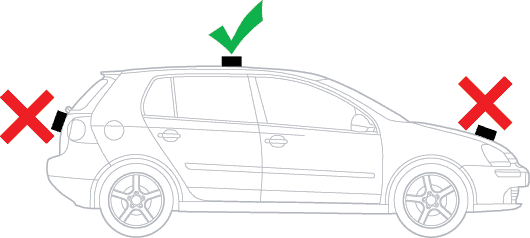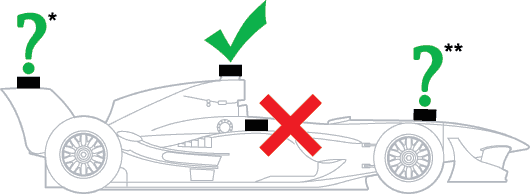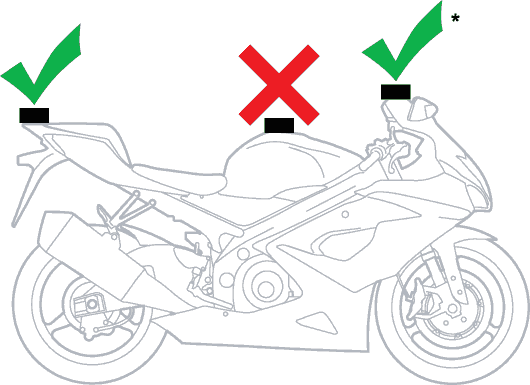Correct Mounting of the GPS Antenna
"WARNING": To avoid any possible damage to the car paintwork, please take care when mounting magnetic GPS antennas. In particular make sure that there are no dust or grit under the antenna. In some cases it maybe required to add additional protection to the paintwork prior to mounting the antenna to avoid damage.
For correct, accurate operation of the GPS receiver it is absolutely essential that the antenna is mounted correctly. No correspondence will be entered into with regard to the system accuracy unless the GPS antenna has been mounted as specified.
There are several important aspects to mounting the antenna:
- Make sure that the antenna connector is screwed firmly into the data logger.
- The antenna must have a clear view of the sky in all directions. Note that it is NOT enough that the antenna can see vertically upwards towards the sky, it must also be able to see all the horizons as well. The GPS system actually gets very little positional or speed information from the satellites directly above, it gets far more information from satellites on, or near, the horizon. For example if the antenna was mounted in the bottom of a "bucket", so it could see upwards but no horizons, then the GPS system would lock and provide positional information - but the accuracy would be very poor. In practice this all means that the antenna must be mounted on the highest point on the vehicle.
- The antenna must be mounted on a horizontal surface. The antenna must be mounted on a horizontal orientation facing directly up. The underside of the antenna cannot receive GPS information, similarly don't mount the antenna on a vertical surface. A maximum angle of 20 degrees is acceptable.
- The antenna must not be covered in tape, in particular dark coloured tapes. Many tapes absorb the weak GPS radio signal. In general black tapes are the worst in this respect as they contain high amounts of carbon - however to be safe, avoid using any tapes.
- The antenna must not be subjected to high levels of vibration. Although the antenna is physically robust to vibration, it can and does effect GPS reception, so isolate it as much as possible.
- The antenna must be physically remote from sources of electrical noise. The GPS radio signal is very weak and can easily be blocked out by radio interference, so to get a good signal the antenna must be as far away from radio interference as possible. By far the biggest source of radio interference is a petrol engine's ignition system, so keep the antenna away from all aspects of it including the engine management system, coil, leads, distributor etc.
- Keep the antenna away from any video cameras, these can generate a large amount of radio interference.
- Avoid trapping or pinching or kinking the antenna cable. The lead from the GPS antenna to the receiver is a special very high frequency cable and it is not normally practical to repair it - so if you do trap, pinch or cut it then the antenna will have to be replaced, and this isn't covered by the guarantee! - so don't try and fit it into a shut gap that is too small or compress it with a door seal etc.
- If at all possible, mount the antenna on a metal platform (a metal car roof is ideal!). The GPS radio signal is amplified if the antenna is mounted on a metal plate (termed a ground plane), and the bigger the better. It is not essential for correct operation, but it is desirable.
- Allow time for the GPS system to lock on before sampling data. The GPS receiver does take a minute or two to lock on to all the available satellites. The time to lock onto satellites varies significantly with conditions but is minimised if the vehicle is stationary.
Recommended mounting positions
If the vehicle has a roof, this is ideal, alternatively the best mounting position on a car may be the roll over bar or the top of the windscreen. On a motorbike, mounting is a little more difficult, but the best compromise is on a flat area of the fairing, just behind the rider. Poor mounting positions on a car include behind the front or rear windscreens.
Note that if you fail to adhere to the guidelines above, the GPS will still probably perform "adequately" "most" of the time, however when conditions are more challenging (with tree cover or bad weather etc) the accuracy will be disappointing.
* Antenna placement on the rear spoiler must be at the highest point, so the view of all horizons is not obscured by any section. It must also be mounted horizontally.
** Antenna placement on the nose cone of the vehicle is acceptable but not ideal. The view of the horizon will be obscured by the high area behind the driver.
This will loose view of satellites at certain points on the track and will affect the accuracy, particularly in difficult conditions.
* Antenna placement on the front fairing must be at the highest point, so the view of all horizons is not obscured by any section. It must also be mounted horizontally.




